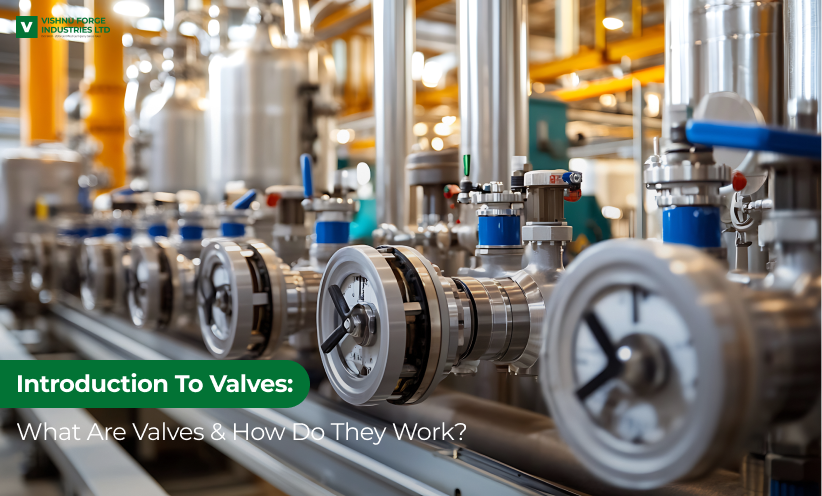Forging solutions created Valves play a crucial role in various industries, from oil and gas to water treatment. These mechanical devices are essential for controlling the flow, pressure, and direction of fluids such as liquids, gases, or slurries. Understanding the basics of valves and how they work is fundamental to grasp their significance in everyday life and different industrial applications.
Understanding the Basics of Valves
Forging solutions created Valves can be defined as devices that regulate or control the flow of fluids within a system. They function by opening, closing, or partially obstructing the passage of fluid to manage its flow rate and pressure. By controlling fluid flow, valves enable the efficient operation of various processes, systems, and machines.
Valves operate in a wide range of industries, including oil and gas, water treatment, pharmaceuticals, and manufacturing. They are crucial components in ensuring the safe and effective transportation of liquids, gases, and slurries. Valves can handle different types of media, from corrosive chemicals to high-pressure steam, making them versatile in various applications.
Definition of Valves
In simple terms, valves are mechanical devices designed to control, regulate, or isolate the flow of fluids. They come in different sizes, designs, and materials to suit specific applications and operating conditions.
Valves can be manual, where an operator adjusts the flow by hand, or automated with actuators for remote operation. The choice of valve type depends on factors such as flow rate, pressure, temperature, and the nature of the fluid being controlled. Some common types of valves include ball valves, gate valves, globe valves, and butterfly valves, each serving a unique purpose in fluid control.
Importance of Valves in Everyday Life
Forging solutions Valves are present in numerous everyday objects and systems, although they often go unnoticed. From faucets and showerheads in our homes to the pipes and valves in municipal water supply systems, these devices play a vital role in managing and controlling water flow. Valves are also found in heating and cooling systems, fuel supply systems, and various appliances.
Moreover, valves are essential for safety in many industrial processes. They can act as emergency shut-off devices to prevent leaks, spills, or overpressure situations that could lead to accidents or environmental hazards. Regular maintenance and proper selection of valves are critical to ensure their reliable performance and longevity in both domestic and industrial settings.
Different Types of Valves
Valves come in a wide range of types and designs, each serving a specific purpose and function within a system. Some commonly used valves include gate valves, ball valves, and butterfly valves.
Gate valves are commonly used to start or stop the flow of fluid by allowing or blocking the passage entirely. These valves consist of a gate or wedge-shaped disc that slides up and down between two parallel seats within the valve body. When the gate is fully lifted, the valve is fully open, allowing for unrestricted flow. Conversely, when the gate is fully closed, the valve is tightly shut, blocking the flow of fluid.
Gate valves are widely used in various industries, such as oil and gas, water treatment, and power generation. Their robust design and ability to handle high-pressure applications make them ideal for controlling the flow of fluids in pipelines and other systems. The gate valves’ simple yet effective mechanism ensures a reliable and efficient operation, ensuring that the fluid flow is precisely regulated.
Ball Valves
Ball valves utilize a spherical ball with a hole in the center to control fluid flow. When the ball is in the closed position, perpendicular to the direction of flow, the valve is shut. Rotating the ball 90 degrees aligns the hole in the ball with the pipe, allowing fluid to pass through the valve. Ball valves are known for their tight sealing capabilities and high flow capacity.
Ball valves are widely used in industries where precise control and quick shutoff are required. Their compact design and reliable performance make them suitable for a wide range of applications, including chemical processing, HVAC systems, and water treatment plants. The ball valves’ ability to handle high-pressure and high-temperature conditions makes them a popular choice in demanding environments.
Butterfly Valves
Butterfly valves are characterized by a disc or plate that is positioned vertically within the valve body. When the disc is perpendicular to the flow direction, the valve is closed, preventing fluid passage. Rotating the disc parallel to the flow direction opens the valve and allows for unrestricted flow. Butterfly valves are often used in applications that require a quick shutoff or control of large flows.
Butterfly valves are widely used in industries such as water and wastewater treatment, food and beverage, and pharmaceuticals. Their compact size, lightweight construction, and ease of operation make them a popular choice for various applications. The butterfly valves’ ability to provide a tight seal and handle high flow rates makes them suitable for controlling the flow of fluids in large pipelines and systems.
When selecting a valve for a specific application, it is essential to consider factors such as the type of fluid, pressure and temperature conditions, and the required flow control. Each valve type has its unique advantages and limitations, and understanding their characteristics is crucial in ensuring optimal performance and reliability in any system.
The Inner Workings of a Valve
Valves, intricate devices that regulate fluid flow, are marvels of engineering with a variety of types, each designed for specific applications. These versatile components are crucial in industries such as oil and gas, water treatment, and manufacturing, where precise control over fluid movement is paramount. Delving into the inner workings of a valve unveils a world of precision and functionality.
Although valves come in different types, they typically share similar components that enable their operation and control over fluid flow. Understanding these components and the role of pressure in valve operation is essential to comprehend how valves function.
Components of a Valve
Most valves consist of a valve body, bonnet, actuator, stem, disc, and seats. The valve body houses the internal components and provides the connection points for the pipeline. The bonnet encloses and protects the internals of the valve. The actuator, such as a lever or motor, provides the mechanism to open or close the valve. The stem connects the actuator to the disc, while the disc, also known as the closure element, controls the flow. Seats, made of resilient materials, provide a sealing surface to prevent leakage when the valve is closed.
Additionally, some valves may feature intricate designs such as flow restrictors, cavitation control mechanisms, or special coatings to withstand corrosive fluids. These enhancements cater to specific operational requirements, showcasing the adaptability and customization options available in valve technology.
The Role of Pressure in Valve Operation
Pressure plays a crucial role in the operation of valves. The force exerted by the flowing fluid against the disc influences the ability of the valve to open or close. In some cases, higher pressure may assist in keeping the valve closed or ensure a tight seal when closed. On the other hand, specific valve designs utilize pressure differentials to aid in opening the valve against the flow or create a tight seal when closed.
Moreover, modern valves often incorporate advanced pressure regulation features such as pressure relief valves, pressure sustaining valves, and pressure reducing valves. These specialized mechanisms cater to varying pressure conditions, ensuring optimal performance and safety in diverse industrial settings. The intricate interplay between pressure and valve components underscores the precision engineering behind these essential devices.
Valve Applications in Various Industries
Valves find application in a wide range of industries, including oil and gas exploration and production, water treatment, pharmaceuticals, chemical processing, power generation, and many more. Here, we will explore their significance in the oil and gas industry and the water treatment industry.
Valves in the Oil and Gas Industry
In the oil and gas industry, valves are critical for controlling the flow of crude oil, natural gas, and various petroleum products. They are used in wellheads, pipelines, refining processes, storage tanks, and offshore platforms. Valves ensure the safe and efficient transportation, processing, and distribution of oil and gas, allowing for proper regulation of pressure, flow, and direction within the network.
Valves in the Water Treatment Industry
The water treatment industry heavily relies on valves to manage the treatment and distribution of water. Valves play a vital role in processes such as filtration, disinfection, chemical dosing, and water distribution. They help regulate flow rates, control the movement of water between treatment stages, and prevent backflow or contamination. Valves also aid in the isolation of specific parts of the water distribution network for maintenance or repairs.
Maintenance and Troubleshooting of Valves
Proper maintenance and regular inspection of valves are essential to ensure their optimal performance, longevity, and reliability. Understanding common valve problems and following recommended maintenance practices can help prevent issues and enhance their efficiency.
Common Valve Problems
Forging solutions Valves can experience various issues, such as leakage, sticking, excessive wear, corrosion, or damage to seals and gaskets. These problems can result from factors like improper installation, inadequate maintenance, abnormal operating conditions, or material degradation. Regular inspection, lubrication, and repair or replacement of worn or damaged components are vital to address these problems.
Tips for Valve Maintenance
Implementing a systematic maintenance plan can extend the lifespan of valves and optimize their performance. Some key maintenance tips include regular inspection, cleaning, lubrication, and testing of valves. It is crucial to follow manufacturer guidelines, use proper tools and equipment, and train personnel adequately to handle valve maintenance tasks.
As we have seen, valves are essential components in various industries and play a significant role in ensuring the efficient and safe operation of fluid systems. Understanding the basics of valves, their types, inner workings, and maintenance requirements enables proper utilization and troubleshooting, leading to improved system performance and reliability.



